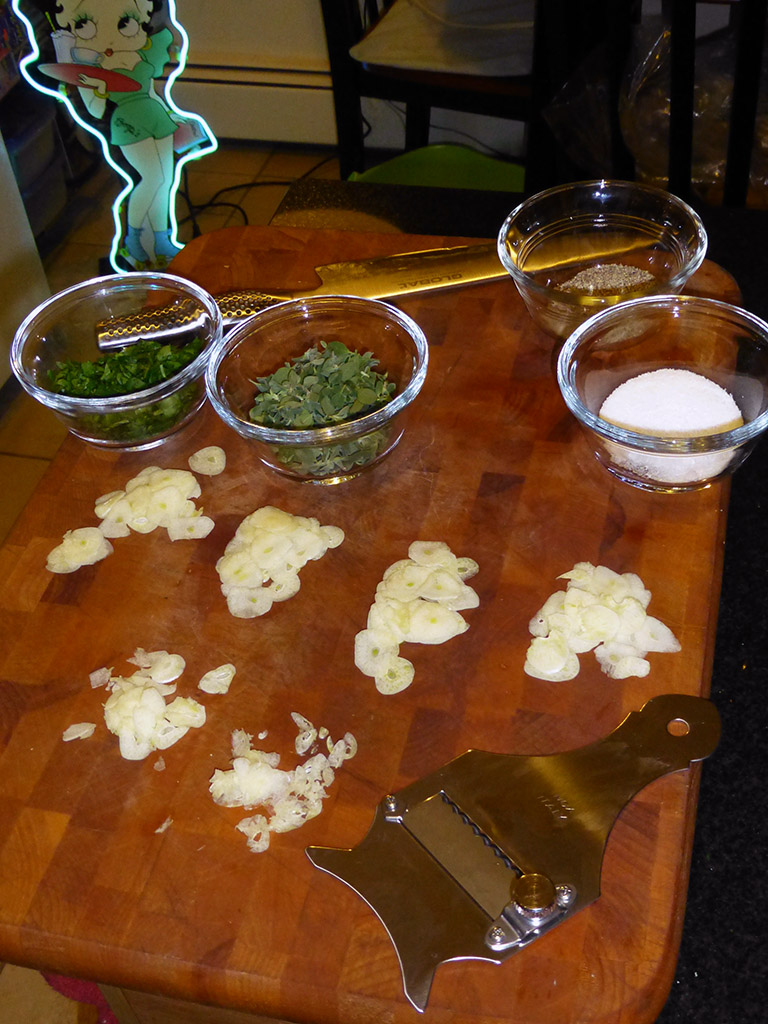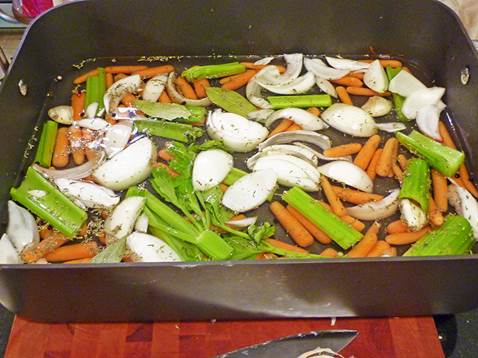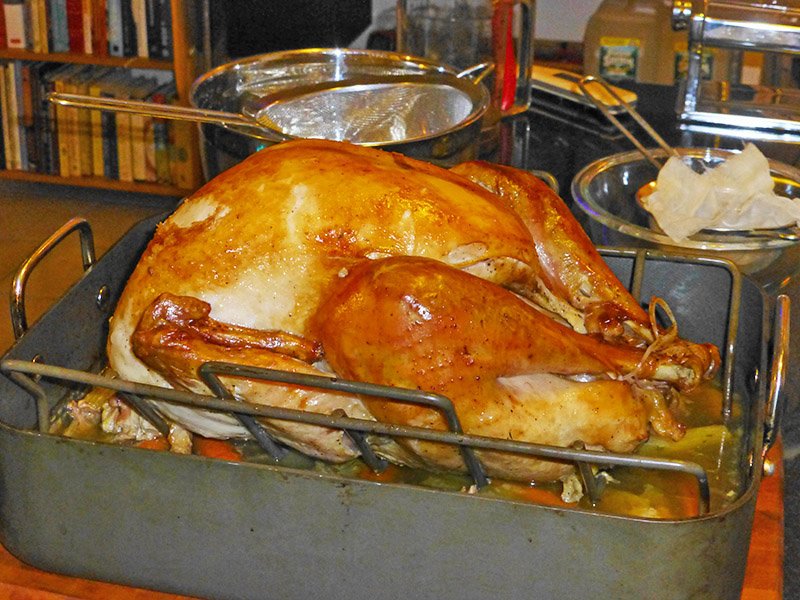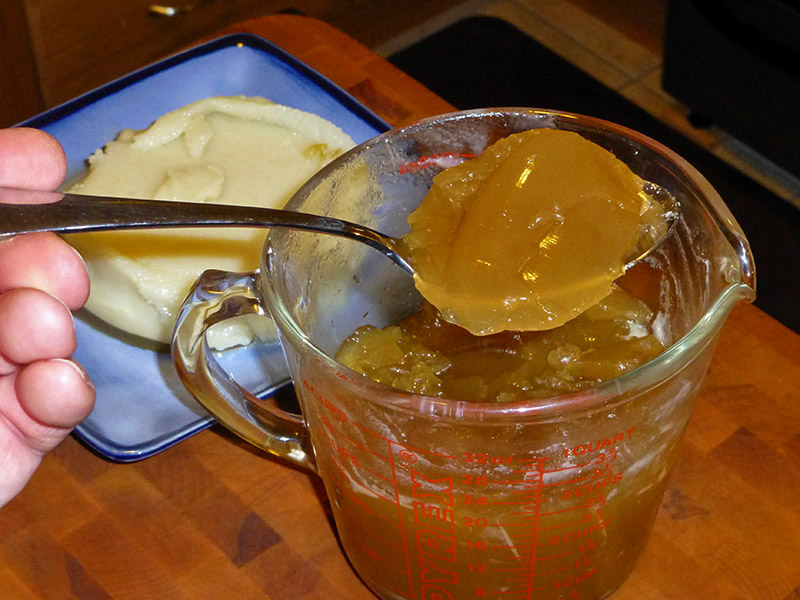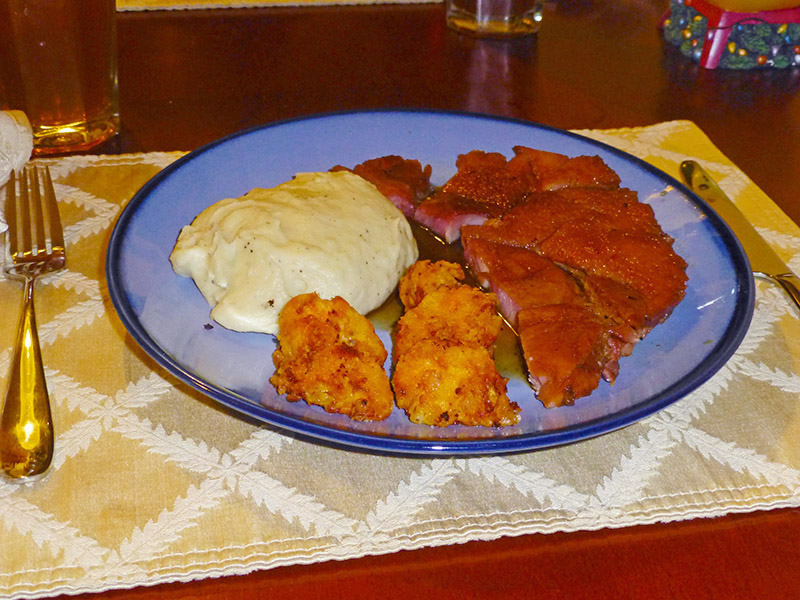
Click for a larger version
Printing tip: At the bottom of each article on the site, a print/PDF/email function allows you to print or save a PDF of just the body of the article without any web site formatting. Scroll to the end of the article and find these icons:  In the print dialog, you can click any element you don’t need to remove it from the printed/saved version.
In the print dialog, you can click any element you don’t need to remove it from the printed/saved version.
parislights wanted to make this again and asked that I repost the recipe, so here it is…
This recipe from Manhattan’s Comfort Diner, with its unusual use of oats instead of bread crumbs, produces a delightfully soft-textured meatloaf that’s miles away from the mundane and typical dense-pack meatloaf that I find somewhat unpleasant.
The original recipe from The Comfort Diner Cookbook is below. Note: My changes to the recipe, which are substantial and I think important, are immediately below it.
Mom’s Meatloaf
Ingredients:
- 3 tablespoons olive oil
- 2 garlic cloves, minced
- 1 cup finely diced white onion (1 medium-size onion)
- 1 cup finely diced celery (2 to 3 stalks)
- ¼ cup finely diced green bell pepper (from 1 bell pepper)
- 1 tablespoon dried basil
- 1 tablespoon dried thyme
- 1 tablespoon dried oregano
- 2 large eggs
- 1 cup whole milk
- 1 cup plain whole oats
- 1 pound ground beef [80-85% lean]
- ½ pound ground veal (if you don’t want to use veal, just increase the ground beef to 1 ½ pounds)
- ½ pound ground pork
- ½ tablespoon table salt
- ½ tablespoon freshly ground black pepper
- ¼ cup Worcestershire sauce
- ½ cup canned diced tomatoes, drained
- ½ cup ketchup or canned diced tomatoes, for topping
Directions:
- Preheat the oven to 325F/160C. In a large sauté pan on medium heat, warm the olive oil, then add the garlic, onion, celery, bell pepper, basil, thyme, and oregano. Sauté the vegetables for 3 to 4 minutes, until they begin to soften.
- In a bowl, whisk together the eggs and milk. Add the oats.
- In a large bowl, combine the meats well by hand. Season with the salt and pepper. Pour the liquid mixture over the blended meats and mix thoroughly to combine. Add the Worcestershire sauce, tomatoes, and sautéed vegetables. Mix well.
- Place the mixture in a 9×12 baking dish and form it into a long, rounded loaf. There should be at least 1 inch of space around the loaf to allow fat to run off.
- Spread the ketchup or diced tomatoes evenly on top of the loaf, and bake for 50 to 60 minutes, until firm and cooked through.
- Remove the meatloaf from the oven and allow to cool for 2 to 3 minutes before serving.
Here are my changes and baking notes:
- Change: The herbs from dried to chopped fresh (I like the grassy note you never get from dried) and the peppers from green to a mix of sweeter bell peppers like red, orange, and yellow
- Double: The onions and the herbs; you’re going to caramelize the onions, meaning two cups will reduce down to maybe two-thirds of a cup, and fresh herbs aren’t as intense as dried
- Triple: The peppers (I use ¼ cup finely diced of each of the three colors)
- Lower: The milk to 2/3 cup or the mixture is almost too sloppy to free-form.
Here are the veg and herbs for the double recipe that I usually make. This amount cooks down to about three cups in the end.

Sautéing the veg substantially changed:
- Caramelize the onions in the olive oil on a medium-high heat to a mahogany color, stirring frequently so they don’t burn; I double the quantity because they shrink to almost nothing. This is going to take a while – don’t believe the majority of TV chefs and recipes that tell you caramelizing onions takes 10 or 12 minutes, because someone else did it for them and they haven’t done it themselves for many years – or they’re just lying because no one wants to hear it takes half an hour. In any case, it’s worth your time.*
- Add the celery and diced peppers when the onions are about 2/3 done
- Add the garlic only in the last couple of minutes to avoid burning it
- Add the herbs to the sauté only in the last minute
- You may find that the mix gets a little too dry during this extended sauté – if that’s the case, add a bit more oil or some oil and butter
*There is a method out there that uses baking soda to supposedly speed-caramelize onions, but I found it saves only a few minutes. Worse, even the tiniest quantity seems to break the onions down so much that you end up with onion mush…nicely colored, sure, but mush. It’s a cynic’s view, I’ll admit, but I think some of the sites propounding this method just might be using traditionally caramelized onions in their photos, because no one wants to see a mound of mush.
This is what your elixir will look like after sautéing. Your house smells good now, too, doesn’t it?

Tips:
I usually combine the milk, eggs, and oatmeal in a bowl before I start sautéing the veg and herbs. By the time the veg are done, the oatmeal has soaked up a good bit of the liquid, which makes for easier mixing.
You may need to adjust the seasoning, so make a small, thick patty from an ounce or two of the finished mixture and sauté it over medium heat, turning frequently, to an internal temp of 160F/72C so you can safely taste it. E coli is hardier than some critters and lives right up to 150F/65C, so for this recipe, a probe thermometer should be your close friend. The right internal temperature is especially important in the finished loaf. I use a TempTest 1, a sort of compact version of the same company’s more well-known Thermapen, but much cheaper ones like their Super-Fast pocket model, an Oxo instant read you can pick up at Bed Bath & Beyond, or this Taylor from Amazon – the one I use at my office – are similarly accurate, just not as fast as the more expensive models.
If you make two loaves at a time as I usually do, your mis en place is probably going to take about 35 minutes if you’re fairly proficient – 45 if you’re also making mash from a boatload of potatoes. Let’s call it an hour if you further add a passel of carrots. There’s a helluva lot of stuff to peel, dice, and slice when you make two loaves and a couple of sides.
Baking changes:
Line a pan with heavy duty tinfoil and put a fairly close-mesh wire rack in the pan. Fold a piece of heavy duty tinfoil to the size of the loaf you intend to form (about 10×5″) and place on the rack. When you put the loaf on this, it will stop the mixture squidging through the rack underneath but will also allow the fat to drip off into the lined pan below as the meatloaf cooks. This way, it’s not swimming in its own fat at the end.
If the mixture is on the loose side – and it almost certainly will be – you can refrigerate it for a few hours or overnight before forming, or be brave and form it anyway, then get it out of the oven at about fifteen minutes and, using a couple layers of food prep gloves to avoid burning yourself, push the sides in to get its height back. I’ve done that more than once, but I don’t recommend it.
These days, I always do all the prep one evening, chill the finished mixture overnight, and bake it for dinner the next night after a day of delightful anticipation. I think the finished flavor is improved when the ingredients have plenty of time to insinuate themselves upon each other overnight, but the real bonus is that all you have to prep the next night is your vegetable sides. It’s a very satisfying method.
For this double recipe, I refrigerated the mix overnight to firm it up nicely, then packed half at a time into a loaf pan and unmolded onto the foil islands on top of the wire rack like so. When the mixture is well-chilled beforehand, the loaves don’t slump at all in the oven.

The meatloaves on their foil islands shortly after going in the oven, holding their shape nicely after chilling overnight
In my experience, the 50 to 60 minutes in the recipe well underestimates the baking time. It’s more like 80 to 90 minutes when you have a properly tall loaf. Just use an instant-read thermometer to ensure the very middle of the loaf is 160F/72C. Any little critters that may have been along for the ride will be pushing up teeny-tiny daisies by then.
I don’t paint the ketchup on top until baking is about three-quarters done, when the internal temperature is past 120F/50C (don’t forget to wash the thermometer probe afterward). This way, it still darkens and thickens nicely, but doesn’t form the almost burned crust of the original recipe. The result:

Click for a larger version
Sides that go well with this (they’re all in that picture at the head of the article):
- Julia Child’s garlic mashed potatoes, recipe here (scroll halfway down that page); even without the garlic sauce, mashed done her way is the best way. The key is the drying of the potatoes over low heat after ricing or mashing and before adding the butter and cream. (Sometimes, instead of the slow braising of the garlic in that recipe, I cut the bottoms off two whole heads of garlic, drizzle with olive oil, wrap in foil, and roast in a 400F/200C oven for half an hour, then simply squeeze the tamed and softened cloves into the mash.) Keep tasting the mashed as you add salt and pepper until it makes you go “Mmmm.”
- Carrot coins braised in butter, just barely bubbling on medium-low heat until tender, then glazed with a touch of brown sugar and garnished with a handful of the carrot’s close cousin, parsley. I usually peel and slice about 3 pounds, which needs two sticks of butter to partially cover the carrots; stir it occasionally as it braises. Serve with a slotted spoon so you don’t have a puddle of butter on the plate.
- Alton Brown’s Better Than Granny’s Creamed Corn, recipe here. Be sure to add plenty of freshly ground pepper at the end, tasting continually – you’ll know it immediately when you’ve hit the sweet spot.
What do do with leftovers: Heat thick slices and serve on lightly toasted whole wheat slathered with grainy mustard and mayo.
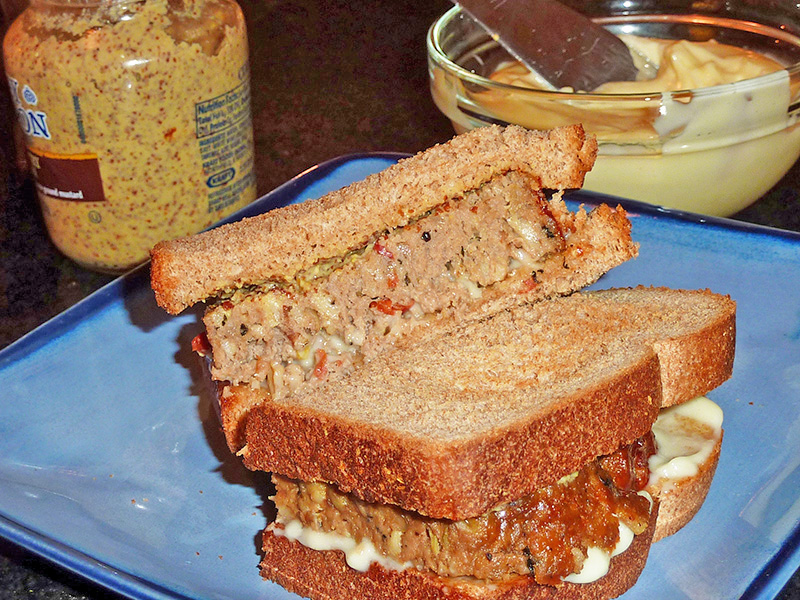
Feeling ambitious? Make some of this for your sandwiches:

Homemade Mayonnaise
All you do is whisk together these six things in a medium sized bowl (tip: wet a kitchen towel, form it into a circle, and place your bowl onto it for stability while whisking):
1 egg yolk
1 teaspoon water
½ teaspoon salt
A few grinds of white pepper
1 ½ teaspoons lemon juice
1 teaspoon apple cider vinegar
Then, using a Pyrex glass measure with pouring lip or something similar, whisk in 1 cup of oil (I often use canola), by drops at first to start the emulsion, then a thin stream, then a thicker stream, whisking briskly all the while. Then you adjust seasonings as necessary. And you look at the clock and just four or five minutes has passed since you started.
It almost seems too simple to produce something so tasty and useful. In fact, it’s so good and so easy that you may look out the window to see if the Commercial Mayonnaise Police are outside, waiting to break your door in whilst shouting, “What’s all this, then?!”
If you’re familiar with Trader Joe’s mayonnaise, this is much the same in flavor. If you prefer the taste of Hellman’s/Best mayonnaise, you can cut back on the lemon juice and add some mustard powder.
Edited November 2018 to add this even easier method that you can use if you have a stick blender:
2-Minute Stick Blender Mayonnaise
In a jar just wider than your stick blender, place:
1 egg yolk
2 teaspoons water
1/2 teaspoon table salt
1 teaspoon apple cider vinegar
1 1/2 teaspoons lemon juice (if you like a little less tang, lower this to 1 teaspoon)
1/4 teaspoon mustard powder or a teaspoon of mustard
A few grinds of white pepper or black pepper
Carefully pour one cup of neutral vegetable oil like canola on top of those.
Place the stick blender all the way on the bottom of the jar, making sure it encloses the egg yolk.
Pulse the stick blender for a second or two, then wait a second or two. As you repeat this, you will see the emulsion start to form at the bottom. Repeat this pulse-wait cycle eight or ten times. At this point, you are likely to have some oil still sitting on top. Slowly raise and lower the blender to incorporate the rest of the oil.

